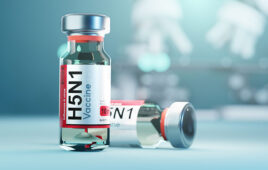 A new method for detection of infection in wounds could take physicians less than a minute to complete, rather than the current 24 hours it takes to plate bacteria and leave it to incubate overnight, according to research by the George Washington University’s (GW) Victoria Shanmugam, M.D.
A new method for detection of infection in wounds could take physicians less than a minute to complete, rather than the current 24 hours it takes to plate bacteria and leave it to incubate overnight, according to research by the George Washington University’s (GW) Victoria Shanmugam, M.D.Shanmugam and co-authors Edgar Goluch, Ph.D., DiPietro Assistant Professor of Chemical Engineering at Northeastern University College of Engineering, and Agnes Chan, Ph.D., assistant professor at the J. Craig Venter Institute, published this new method in the journal Wound Repair and Regeneration. The method uses an electrochemical detection strategy to identify molecules produced by the bacteria Pseudomonas, which commonly infects chronic wounds.
The team tested the use of an inexpensive, disposable electrochemical sensor that immediately reveals bacteria based on the detection of pyocyanin, a bacterial quorum sensing molecule produced by Pseudomonas. The probe correctly identified the presence of the bacterium 71 percent of the time and correctly identified absence of the bacterium 57 percent of the time.
“Being able to detect Pseudomonas and other infectious organisms at the time of the clinic visit will greatly enhance our ability to take care of patients,” said Shanmugam, director of the Division of Rheumatology at the GW School of Medicine and Health Sciences and principal investigator of the WE-HEAL study, a National Institutes of Health-funded study investigating the interplay of the host immune response and wound bed microbiome in patients with chronic wounds. “We would not have to wait for culture results before making a decision about antibiotics, and this would allow us to better tailor therapies for our patients.”
After further enhancement and testing, probes harnessing this methodology could potentially provide a way for physicians to detect wound infections at the bedside, allowing physicians to switch from broad-spectrum antibiotics to specific directed therapies sooner, lowering health care costs, minimizing drug resistance, and improving patient care outcomes.
“Infections are a major challenge in medicine, and by using this probe, we were able to harness one of the unique molecules produced by bacteria to detect infection,” said Shanmugam. “Through this ongoing collaboration with Dr. Goluch’s team of engineers, we plan to continue to refine this testing method and hope to scale it up for detection of other bacteria and to optimize it for clinical use.”
Filed Under: Drug Discovery



